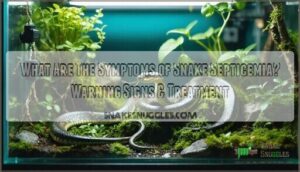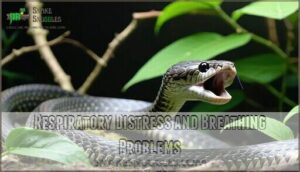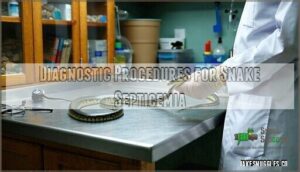This site is supported by our readers. We may earn a commission, at no cost to you, if you purchase through links.

Your snake might show breathing difficulties, lethargy, muscle spasms, or loss of coordination. Look for small purplish-red spots on the belly – they’re like warning flags your snake’s immune system is waving.
You might also notice behavioral changes, appetite loss, or unusual discharge from the mouth or nose. Septicemia spreads fast through your snake’s bloodstream, making early detection vital.
Temperature fluctuations and poor hygiene often trigger this bacterial invasion. Think of it as your snake’s body fighting an internal war – the sooner you spot the battle signs, the better the outcome, as early detection is vital for your snake’s health, and it’s a matter of life.
Table Of Contents
- Key Takeaways
- What is Snake Septicemia?
- Early Warning Signs of Snake Septicemia
- Physical Symptoms of Septicemia in Snakes
- Diagnostic Procedures for Snake Septicemia
- Treatment Options for Snake Septicemia
- Complications of Untreated Snake Septicemia
- Preventing Septicemia in Captive Snakes
- Differentiating Septicemia From Other Snake Diseases
- Recovery and Prognosis for Snake Septicemia
- When to Seek Emergency Veterinary Care
- Frequently Asked Questions (FAQs)
- What are the first signs of septicemia?
- How do you treat septicemia in reptiles?
- What is the first stage of septicemia?
- How do you know if a snake is infected?
- How do I know if my snake has sepsis?
- What are the early warning signs of septicemia?
- How to prevent septicemia in snakes?
- How does septicemia affect a snakes organs?
- Can septicemia be transmitted between snakes?
- Are certain snake species more susceptible to septicemia?
- Conclusion
Key Takeaways
- Watch for early warning signs – You’ll notice lethargy, appetite loss, breathing difficulties, and red patches on your snake’s belly before the infection becomes life-threatening.
- Recognize physical symptoms quickly – Look for skin discoloration, open-mouth breathing, muscle weakness, and neurological signs like seizures or loss of coordination.
- Seek immediate veterinary care – Don’t wait when you see multiple symptoms together, as septicemia spreads rapidly through the bloodstream and can cause organ failure within hours.
- Prevention beats treatment – You can avoid septicemia by maintaining clean enclosures, proper temperatures and humidity, treating wounds promptly, and reducing stress in your snake’s environment.
What is Snake Septicemia?
Snake septicemia is a life-threatening bacterial bloodstream infection that occurs when harmful bacteria multiply rapidly throughout your snake’s circulatory system, causing widespread tissue damage and organ dysfunction.
When bacteria invade your snake’s bloodstream, every second counts in preventing fatal organ shutdown.
You’ll typically encounter this serious condition when bacteria from wounds, poor environmental conditions, or parasitic infestations overwhelm your snake’s immune defenses and enter the bloodstream, leading to a potentially fatal outcome due to organ dysfunction.
Definition of Septicemia in Snakes
Understanding septicemia in snakes means recognizing a life-threatening bacterial infection that hijacks your pet’s bloodstream.
This serious blood disorder occurs when harmful bacteria invade the circulatory system, creating widespread havoc throughout your snake’s body.
Snake septicemia symptoms develop as these bacterial invaders:
- Multiply rapidly in the bloodstream
- Release dangerous toxins into essential organs
- Trigger severe inflammatory responses
This bacterial infection represents one of the most critical snake health emergencies, demanding immediate reptile care and professional veterinary intervention.
Maintaining hygiene can prevent bacterial entry through wounds to reduce the risk of septicemia in snakes.
Common Causes of Snake Septicemia
Snake septicemia develops when bacteria invade your snake’s bloodstream through various pathways.
Wound infections from untreated injuries create primary entry points, while poor husbandry practices weaken immune defenses.
Parasite vectors like mites transport harmful bacteria, and oral transmission occurs through contaminated prey or water sources.
| Primary Causes | Contributing Factors |
|---|---|
| Untreated wounds | Improper temperature control |
| Bacterial contamination | Inadequate humidity levels |
| Parasite vectors | Dirty substrate materials |
| Infected prey items | Overcrowded living conditions |
Stress factors including handling, environmental changes, and concurrent illnesses substantially increase susceptibility to bacterial infection, making proper wound care and habitat maintenance your first line of defense.
Risk Factors for Septicemia in Snakes
Several factors increase your snake’s vulnerability to septicemia.
Poor husbandry creates perfect conditions for bacterial growth – dirty substrates, incorrect temperatures, and high humidity levels compromise immunity.
Wound exposure from injuries or cage mate aggression provides direct bacterial entry points.
Parasite vectors like mites weaken immune defenses while carrying harmful bacteria.
Stress, malnutrition, and immunosuppression leave your snake defenseless against snake septicemia causes, making prevention through proper care absolutely critical.
Bacterial Agents Involved in Snake Septicemia
Bacterial culprits behind snake septicemia aren’t random troublemakers—they’re specific opportunistic pathogens that exploit weakened immune systems.
When conditions align, these microscopic invaders transform your snake’s bloodstream into their playground.
- Aeromonas virulence and Pseudomonas pathogenicity dominate Gram-negative bacteria infections, causing rapid systemic damage
- Citrobacter SCUD specifically targets aquatic species, creating ulcerative skin lesions alongside bacterial septicemia
- Antibiotic resistance complicates treatment, making early septicemia diagnosis critical for successful intervention
Early Warning Signs of Snake Septicemia
Recognizing early snake septicemia symptoms can save your pet’s life. These initial warning signs often appear days before severe complications develop, making early detection vital for successful treatment outcomes.
Watch for these critical early warning signs:
- Lethargy onset – Your snake becomes unusually inactive, hiding more frequently, and shows reduced responsiveness to normal stimuli like handling or feeding time
- Appetite changes – Sudden refusal to eat or decreased interest in food, even when offering preferred prey items at ideal temperatures
- Unusual behavior – Decreased tongue flicking, abnormal posturing, or subtle changes that make your snake seem "off" from baseline behavior
Skin discoloration may begin as faint redness or small purplish spots on the belly scales. Breathing difficulty can start as occasional open-mouth breathing during rest periods. These snake septicemia symptoms require immediate veterinary attention, as septicemia diagnosis depends on recognizing these snake infection symptoms before they progress to life-threatening stages. Addressing the red patchiness symptom early is critical for effective intervention.
Physical Symptoms of Septicemia in Snakes
When septicemia develops in your snake, you’ll notice distinct physical changes that signal serious bacterial infection in the bloodstream.
These visible symptoms often appear alongside behavioral shifts and require immediate veterinary attention to prevent organ failure and death.
Changes in Skin Appearance
When examining your snake’s skin, scale discoloration serves as a critical warning sign.
Red blotches and swollen areas indicate bacterial invasion, while skin necrosis and ulcerative dermatitis signal advanced infection.
Discolored scales appear darker or lighter than normal.
These snake septicemia symptoms require immediate veterinary attention to prevent systemic spread of infection.
Respiratory Distress and Breathing Problems
Beyond skin changes, your snake’s respiratory system often reveals septicemia’s grip.
Watch for these warning signs:
- Open-mouth breathing – your snake gasps for air constantly
- Rales and wheezing – audible clicking or gurgling sounds during respiration
- Unusual positioning – head elevated to ease breathing difficulties
- Oxygen deprivation signs – pale gums indicating compromised circulation
Increased breathing rate signals your snake’s struggling lungs fighting infection.
Snakes lack a diaphragm and as a result cannot effectively cough.
Behavioral Changes and Lethargy
While breathing difficulties grab attention, your snake’s behavior tells an equally important story.
Activity Reduction and Appetite Loss are hallmark signs of snake septicemia, as infected snakes conserve energy to fight the bacterial invasion.
| Behavior | Healthy Snake | Septicemic Snake |
|---|---|---|
| Movement | Active exploration | Minimal movement, Muscle Weakness |
| Feeding Response | Strikes at prey | Refuses food completely |
| Alert Level | Responsive to touch | Sluggish reactions |
| Positioning | Various locations | Constant Hiding Behavior |
| Social Withdrawal | Normal interaction | Avoids handling |
Lethargy progresses rapidly in septicemia cases, making early recognition vital for successful treatment outcomes.
Digestive System Disturbances
Your snake’s digestive troubles often signal septicemia in snakes.
Regurgitation issues appear as undigested meals expelled hours after feeding.
Anorexia signs include refusing food entirely or showing disinterest in prey.
Fecal changes manifest as watery, bloody, or unusually colored droppings.
Gut motility decreases, causing constipation or bloating.
Malabsorption problems prevent proper nutrient uptake, leading to weight loss despite eating.
Neurological Symptoms
Neurological complications from septicemia in snakes represent severe systemic damage.
You’ll notice muscle control loss, paralysis affecting movement, and disorientation where your snake appears confused.
Convulsions and seizures indicate critical brain involvement requiring immediate veterinary intervention.
These neurological impairment signs mean the infection has progressed dangerously, making emergency treatment essential for survival.
Maintaining clean enclosures helps prevent bacterial entry through wounds.
Diagnostic Procedures for Snake Septicemia
When you suspect septicemia in your snake, proper diagnostic procedures are essential for confirming the infection and determining the best treatment approach.
Your veterinarian will use a combination of physical examination, laboratory tests, and specialized analyses to accurately diagnose this serious bacterial blood infection, which is a critical step in managing the condition effectively.
Physical Examination Techniques
During scale examination, your veterinarian will thoroughly assess your snake’s overall condition through systematic hands-on evaluation. This thorough approach helps identify septicemia in snakes before symptoms become life-threatening.
Essential examination components include:
- Scale Examination – Checking for discoloration, lesions, and abnormal texture indicating snake septicemia
- Palpation Techniques – Gently feeling along the body to detect swelling or masses
- Auscultation Use – Listening to heart and lung sounds with specialized equipment
- Hydration Assessment – Testing skin elasticity and mucous membrane color
- Neurological Exam – Evaluating reflexes and movement patterns for snake disease symptoms
Blood Tests and Cultures
Two critical blood tests help veterinarians confirm septicemia in snakes and identify the specific bacterial culprits.
These diagnostic procedures provide essential information about your snake’s infection severity and guide targeted treatment decisions.
- Complete blood count – Reveals elevated leukocyte count and potential blood parasites indicating systemic infection
- Bacterial cultures – Identifies specific pathogens using specialized culture mediums for accurate bacterial identification
- Antibiotic sensitivity testing – Determines which medications will effectively combat the snake blood infection
Imaging Studies for Septicemia Detection
Advanced imaging reveals what blood tests can’t capture in snake septicemia cases.
Radiography applications detect organ swelling and fluid buildup, while ultrasound benefits include real-time blood flow assessment.
CT scan usage provides detailed cross-sectional views, and MRI capabilities offer superior soft tissue contrast.
Nuclear imaging tracks infection spread.
These imaging techniques enable early detection before external symptoms worsen your snake’s condition.
Microscopic Analysis of Body Fluids
Your veterinarian examines blood smear samples and performs fluid cytology to identify bacterial invaders.
Gram stain techniques reveal specific bacteria types, while culture results confirm the diagnosis.
Cellular morphology changes indicate infection severity.
These blood tests provide definitive evidence of bacterial infection, enabling targeted treatment for snake septicemia based on precise symptoms analysis.
Early detection can improve outcomes, especially given potential bacterial entry.
Treatment Options for Snake Septicemia
When your snake shows signs of septicemia, immediate treatment becomes critical for survival since this bacterial infection can rapidly progress to organ failure and death.
Treatment typically involves aggressive antibiotic therapy combined with intensive supportive care to stabilize your snake’s condition and eliminate the infection from their bloodstream.
Antibiotic Therapy Protocols
Once your vet confirms septicemia in snakes, they’ll hit hard with targeted antibiotic therapy.
Treatment success hinges on proper drug selection and dosage regimens suited to your snake’s specific bacterial culprit.
- Third-generation cephalosporins like ceftazidime (20-40 mg/kg every 2-3 days)
- Fluoroquinolones such as enrofloxacin (5-10 mg/kg daily) for broad coverage
- Piperacillin/tazobactam combinations for severe systemic cases
- Administration routes vary from intramuscular injections to oral medications
- Treatment duration spans 7-10 days with ongoing resistance monitoring
For those seeking ceftazidime related products, several options are available.
Your vet will adjust antibiotics based on culture results, ensuring the most effective snake antibiotic therapy while minimizing complications.
Supportive Care and Fluid Administration
While antibiotics tackle infection, your snake needs thorough supportive care for septicemia recovery.
Fluid therapy addresses dehydration through subcutaneous or intravenous administration routes, requiring careful monitoring of hydration status.
Nutritional needs become critical as sick snakes often refuse food, necessitating assisted feeding or liquid supplements, and Fluid therapy products are readily available for this purpose.
Home care involves maintaining ideal temperatures and humidity levels to support healing processes and ensure the snake’s environment is conducive to recovery, making fluid therapy a crucial aspect of care.
Surgical Interventions for Severe Cases
When standard treatments fall short, surgical procedures become necessary for severe snake septicemia cases.
These interventions require precision and expertise to address life-threatening complications.
Critical surgical procedures may include:
- Wound debridement – removing infected tissue that threatens your snake’s recovery
- Abscess drainage – eliminating pockets of infection before they spread further
- Organ support procedures – protecting essential systems from septic damage
- Amputation risks – sometimes necessary to save your snake‘s life.
After debridement, it’s beneficial to explore specialized snake products for ideal care.
Post-op care involves careful monitoring, pain management, and sterile wound maintenance.
These procedures carry inherent risks but often represent your snake’s best chance for survival when sepsis threatens multiple organ systems.
Nutritional Support During Treatment
Following surgical intervention, proper nutritional support becomes essential for recovery from septicemia in snakes.
Your snake’s weakened system requires careful dietary management to rebuild strength and immune function.
- Tube Feeding – Provides direct nutrition when appetite is completely absent
- Supplementation Strategies – Essential vitamins and minerals support healing processes
- Hydration Methods – Maintain fluid balance through subcutaneous or oral administration
- Appetite Stimulation – Gentle techniques encourage natural feeding behaviors
Dietary adjustments guarantee your snake receives adequate nutrition during this critical healing phase.
Complications of Untreated Snake Septicemia
When septicemia goes untreated in your snake, the bacterial infection spreads rapidly through the bloodstream, causing widespread organ damage and potentially fatal complications.
You’ll face serious consequences including liver and kidney failure, permanent neurological damage, reproductive system impairment, and your snake’s weakened immune system becomes vulnerable to additional life-threatening infections, leading to a weakened immune system.
Organ Failure and Systemic Damage
When septicemia in snakes goes untreated, multiple systems fail simultaneously.
The inflammation cascade triggers widespread blood clotting disorders, creating dangerous blockages throughout your snake’s circulatory system.
Oxygen deprivation leads to tissue necrosis in essential organs, while septic shock causes complete organ shutdown.
Blood poisoning devastates kidneys, liver, and heart function, making recovery increasingly unlikely without immediate intervention, leading to tissue necrosis and organ shutdown.
Long-term Health Consequences
Even after beating the initial infection, your snake isn’t in the clear.
Organ damage from septicemia in snakes can persist for months, causing recurring infections and neurological effects like coordination problems.
Growth stunting becomes apparent as your pet fails to reach normal size milestones.
These longterm consequences of snake septicemia substantially impact your snake’s reduced lifespan, making ongoing veterinary monitoring essential for managing these persistent snake health issues.
Impact on Reproductive Capabilities
Beyond organ damage, septicemia wreaks havoc on your snake’s reproductive system. Fertility decline becomes inevitable as the infection disrupts hormonal pathways essential for breeding success.
Infected females show reduced egg viability, while males experience decreased sperm quality. The systemic inflammation compromises offspring health even before conception occurs.
- Hormonal disruption – Septicemia interferes with reproductive hormone production, creating cascading fertility issues
- Egg viability reduction – Bacterial toxins damage developing eggs, leading to poor hatching rates or deformed offspring
- Breeding success decline – Infected snakes lose interest in mating behaviors, reducing reproduction opportunities substantially
- Offspring health compromise – Snake sickness symptoms can transfer to developing young through maternal infection
- Recovery timeline extension – Snake organ failure affects reproductive organs, requiring months of healing before normal function returns
Increased Vulnerability to Secondary Infections
When septicemia compromises your snake’s immunity, opportunistic pathogens seize the moment to establish coinfections.
This weakened state creates treatment challenges, as antibiotic resistance may develop while multiple infections overwhelm your pet’s defenses.
Secondary bacterial, fungal, or viral infections can transform manageable snake septicemia symptoms into life-threatening complications requiring aggressive intervention.
Preventing Septicemia in Captive Snakes
You can substantially reduce your snake’s septicemia risk through consistent preventive care and environmental management.
Prevention remains far more effective than treatment, requiring attention to enclosure cleanliness, proper nutrition, stress minimization, and regular health monitoring.
Proper Enclosure Hygiene and Maintenance
Maintain substrate selection like paper towels or cypress mulch that allows easy waste removal.
Implement weekly disinfection protocols using reptile-safe cleaners to prevent septicemia in snakes.
Monitor water quality by changing bowls every 3-4 days. Clean enrichment items monthly.
A clean environment reduces snake illness symptoms and bacterial growth that causes snake septicemia.
Optimal Nutrition and Feeding Practices
Providing nutritionally balanced meals prevents immune system weakness that makes snakes vulnerable to septicemia and other snake diseases.
Feed appropriately sized prey every 1-2 weeks for adults, ensuring proper supplement schedules with calcium and vitamins to maintain peak snake health.
- Prey gut loading with nutritious foods 24-48 hours before feeding maximizes nutritional value
- Dietary variety using different prey species prevents nutritional deficiencies that compromise immunity
- Hydration importance through fresh water bowls supports kidney function and toxin elimination
- Obesity prevention by monitoring feeding frequency reduces stress on organs and immune function
- Supplement schedules with calcium/D3 strengthen bones and support metabolic processes against snake illness symptoms
Stress Reduction Techniques
Reducing reptile stress isn’t rocket science, but it’s essential for preventing snake septicemia.
Chronic stress weakens immune systems, making snakes vulnerable to bacterial infections.
- Enclosure Enrichment: Add hiding spots, climbing branches, and varied substrates to encourage natural behaviors
- Handling Techniques: Limit handling frequency and use gentle, confident movements during necessary interactions
- Quarantine Protocols: Isolate new snakes for 30-60 days to prevent disease transmission and social interaction stress
- Environmental Stability: Maintain consistent temperature, humidity, and lighting cycles to minimize physiological stress
Regular Health Check-ups and Monitoring
Regular visual inspections and weight monitoring catch septicemia in snakes before it becomes life-threatening.
Check your snake weekly for skin discoloration, behavior observation changes, and abnormal shedding patterns.
Monthly fecal exams detect bacterial overgrowth early.
Consistent monitoring transforms you from reactive owner to proactive guardian, keeping snake health prime and symptoms at bay.
Differentiating Septicemia From Other Snake Diseases
You’ll often encounter similar symptoms across different snake diseases, making accurate diagnosis challenging without veterinary expertise.
Septicemia shares key warning signs with respiratory infections, parasitic infestations, viral diseases, and fungal conditions, requiring careful observation of specific symptom patterns to distinguish between these conditions.
Comparison With Respiratory Infections
Distinguishing septicemia in snakes from respiratory infections requires careful observation of overlapping symptoms.
Both conditions share respiratory distress and lethargy, but key differences help guide accurate diagnosis:
- Causative agents: Septicemia involves systemic bacterial spread, while respiratory infections may be bacterial, viral, or fungal
- Diagnostic differences: Blood cultures confirm septicemia; respiratory swabs identify localized infections
- Treatment approaches: Septicemia demands aggressive systemic antibiotics versus targeted respiratory therapy
Septicemia typically shows skin discoloration and neurological signs absent in primary respiratory infections.
Distinguishing From Parasitic Infestations
Parasite vectors create diagnostic challenges when distinguishing septicemia from reptile parasite infestations.
Septicemia shows rapid systemic decline with red skin patches and respiratory distress, while parasites cause gradual weight loss and behavioral changes.
Co-infections complicate diagnosis since immune suppression from parasites enables bacterial invasion.
Preventative measures targeting both conditions require thorough fecal analysis and blood cultures for accurate differentiation.
Similarities to Viral Diseases in Snakes
Viral infections create a diagnostic maze when septicemia enters the picture.
Both conditions trigger similar immune responses, making symptom overlap a real challenge for reptile owners.
- Neurological symptoms appear in both viral diseases and septicemia, including seizures and muscle control loss
- Respiratory distress manifests similarly, with labored breathing and mouth gaping in both conditions
- Lethargy and appetite loss occur universally, making initial differentiation nearly impossible without testing
- Treatment differences become essential – antibiotics work for septicemia but won’t touch viral infections
Overlapping Symptoms With Fungal Infections
Fungal vs. bacterial infections in reptiles often share identical symptoms, creating diagnostic challenges for snake owners.
Both septicemia in reptiles and fungal infections cause skin lesions, respiratory distress, and lethargy. You’ll notice overlapping respiratory symptom confusion that makes identification difficult.
| Symptom Category | Septicemia Signs | Fungal Infection Signs |
|---|---|---|
| Skin Changes | Red blotches, hemorrhages | White/gray patches, scales |
| Breathing | Open-mouth breathing, rales | Wheezing, labored breathing |
| Behavior | Severe lethargy, convulsions | Gradual weakness, hiding |
| Progression | Rapid deterioration | Slower symptom development |
Treatment differences become apparent once proper diagnosis occurs – septicemia requires immediate antibiotic intervention while fungal infections need antifungal medications. Septicemia can arise from bacterial entry through wounds.
Recovery and Prognosis for Snake Septicemia
Your snake’s recovery timeline depends on how quickly you catch septicemia and start treatment, with early cases showing improvement within days.
While severe infections may take weeks to resolve, it’s crucial to monitor the snake’s health closely.
You’ll need to provide ongoing supportive care and watch for signs that the infection might return, as some snakes remain vulnerable to future episodes.
Factors Affecting Recovery Time
Your snake’s recovery speed depends on timing and treatment quality. Treatment delay substantially extends healing time, while prompt antibiotic intervention improves outcomes.
Immune response strength varies by species variation, affecting septicemia treatment success. Organ damage from delayed care increases mortality rate.
Key recovery factors include:
- Age and baseline health – younger snakes typically recover faster
- Antibiotic resistance patterns affecting treatment effectiveness
- Infection severity at diagnosis determining reptile health outcomes
- Environmental conditions during recovery supporting healing
Early recognition of symptoms and immediate veterinary care remain your best defense against prolonged illness.
Long-term Care After Treatment
Following thorough septicemia treatment, your snake requires ongoing vigilance and dietary adjustments to support full recovery.
Monitor for behavioral changes and scar tissue formation at injection sites.
Provide probiotic supplements to restore gut health after intensive antibiotics.
Maintain ideal temperatures and humidity for immune function.
Continue veterinary care schedules and implement strict relapse prevention protocols.
Complete healing from reptile septicemia treatment demands patience and consistent environmental management.
Potential for Recurrence
Although septicemia can return like an unwelcome guest, you can substantially reduce reinfection risk through vigilant care.
Antibiotic resistance develops when treatments aren’t completed fully, making future infections harder to treat.
Your snake’s immunity duration varies, so preventative measures remain essential, and long-term monitoring helps catch early warning signs before reptile septicemia recurrence becomes life-threatening again.
Monitoring for Residual Effects
Even after successful treatment, diligent post treatment care remains essential for your snake’s complete recovery.
Residual infection signs can emerge weeks later, making long term monitoring essential for detecting subtle organ damage or recurring septicemia symptoms.
- Weekly weight checks – Track gradual weight loss indicating metabolic issues
- Behavioral documentation – Note changes in feeding patterns or activity levels
- Skin examination – Monitor for new lesions or delayed healing wounds
- Respiratory assessment – Watch for labored breathing or mouth breathing episodes
Your recovery outlook improves substantially with consistent observation during this critical period.
When to Seek Emergency Veterinary Care
Recognizing when septicemia becomes life-threatening requires understanding which symptoms demand immediate veterinary intervention rather than waiting for your next routine appointment.
You’ll need to act fast when certain red-flag symptoms appear, as septicemia can progress from manageable to fatal within hours in severe cases, which demands immediate action.
Critical Symptoms Requiring Immediate Attention
Recognizing life-threatening septicemia symptoms means watching for rapid deterioration in your snake’s condition.
When blood infections overwhelm the system, immediate veterinary intervention becomes critical for survival.
| Emergency Symptom | What to Look For |
|---|---|
| Skin Lesions | Red, purple, or black patches indicating tissue death |
| Respiratory Failure | Open-mouth breathing, wheezing, gasping for air |
| Neurological Signs | Convulsions, loss of muscle control, abnormal positioning |
| Organ Damage | Severe lethargy, discolored scales, complete loss of appetite |
Respiratory distress combined with neurological symptoms signals septicemia’s deadliest phase—don’t hesitate to seek emergency care.
Assessing Severity of Septicemia
Determining sepsis stages in snake septicemia requires recognizing escalating infection levels. Early bacteremia shows mild lethargy and appetite loss.
Advanced septicemia presents organ damage markers—respiratory distress, neurological symptoms, and skin discoloration. Critical septic shock involves cardiovascular collapse and multi-organ failure.
Blood cultures confirm bacterial presence, while mortality rates increase dramatically without immediate intervention. Quick assessment saves lives.
Preparing for Veterinary Consultation
Thorough preparation transforms a stressful emergency into manageable veterinary care. Document snake septicemia symptoms, behavioral changes, and environmental factors before your appointment. Your Medical History and Health Records provide essential diagnostic information.
- Create detailed symptom timeline – Note when snake sepsis treatment became necessary, including respiratory distress onset
- Document Snake Behavior changes – Record feeding patterns, movement limitations, and neurological symptoms
- Prepare Veterinary Questions – Ask about reptile septicemia diagnosis procedures and treatment protocols
- Organize Health Records – Bring previous exam results, medication history, and husbandry documentation
- Plan Emergency Preparation logistics – Secure transport container and contact reptile veterinary care specialists
Follow-up Care and Observation
Post treatment monitoring helps catch septicemia relapses early. Watch for returning snake septicemia symptoms like lethargy or breathing changes.
Recovery monitoring involves daily health checks using proven observation techniques. Your care plans should include temperature tracking and appetite assessment.
| Monitoring Area | What to Watch For |
|---|---|
| Behavioral Signs | Lethargy, hiding, reduced movement |
| Physical Changes | Skin discoloration, swelling, wounds |
| Respiratory Health | Mouth breathing, wheezing sounds |
| Feeding Response | Appetite loss, regurgitation issues |
| Environmental Needs | Proper temperature, humidity levels |
Follow-up care means sticking to your vet’s reptile septicemia treatment schedule. Don’t skip follow-up appointments—they’re your safety net against snake septicemia diagnosis complications.
Frequently Asked Questions (FAQs)
What are the first signs of septicemia?
Early septicemia signs you’ll notice include lethargy, loss of appetite, difficulty breathing, and red patches or blotches appearing on your snake’s skin, especially the belly area.
How do you treat septicemia in reptiles?
You’ll need aggressive antibiotic therapy with drugs like amikacin or enrofloxacin, plus supportive care including fluid therapy, hospitalization, and nutritional support for 2-4 weeks.
What is the first stage of septicemia?
Bacteremia marks the first stage, where bacteria enter your bloodstream but haven’t yet triggered the body’s inflammatory response that defines full septicemia in snakes.
How do you know if a snake is infected?
You’ll spot infection through lethargy, breathing difficulties, red skin patches, loss of appetite, and discolored scales. Watch for swollen areas, unusual positioning, and skin lesions indicating bacterial spread.
How do I know if my snake has sepsis?
Like a car’s engine warning light flashing red, your snake’s body sends distress signals when sepsis strikes.
Watch for lethargy, difficulty breathing, red patches on skin, loss of appetite, and weakness.
These symptoms indicate bacteria overwhelming your snake’s bloodstream, requiring immediate veterinary intervention.
What are the early warning signs of septicemia?
Early warning signs you’ll notice include lethargy, loss of appetite, difficulty breathing, and red patches or blotches appearing on your snake’s skin, especially the underbelly area.
How to prevent septicemia in snakes?
Keep your snake’s environment pristine—clean enclosures weekly, maintain proper temperature and humidity levels.
Treat wounds immediately, control parasites regularly, reduce stress through adequate hiding spaces.
Schedule routine veterinary checkups to catch problems early, and ensure proper temperature and humidity levels are maintained to keep your snake healthy.
How does septicemia affect a snakes organs?
Septicemia strikes like wildfire through your snake’s body, causing bacteria to overwhelm organs with inflammatory toxins.
You’ll see oxygen deprivation damage essential systems, leading to organ failure and shutdown without prompt antibiotic intervention.
Can septicemia be transmitted between snakes?
Direct snake-to-snake transmission of septicemia doesn’t typically occur.
Since it’s caused by bacterial infections entering through wounds, poor husbandry, or compromised immune systems rather than contagious pathogens spreading between healthy animals, this understanding is crucial for preventing the disease.
Are certain snake species more susceptible to septicemia?
Like a double-edged sword, some species face higher septicemia risks than others.
You’ll find that immunocompromised snakes, aquatic species, and those with thinner skin—like ball pythons and corn snakes—show greater susceptibility to bacterial bloodstream infections.
Conclusion
Think of septicemia as your snake’s internal alarm system going haywire – recognizing what’re the symptoms of snake septicemia can mean the difference between recovery and tragedy.
You’ve learned that lethargy, breathing difficulties, skin discoloration, and behavioral changes serve as critical warning flags.
Early intervention with proper veterinary care dramatically improves outcomes, while delayed treatment often leads to organ failure.
Stay vigilant, maintain excellent husbandry practices, and don’t hesitate to consult an exotic veterinarian when symptoms appear.
- https://enviroliteracy.org/animals/how-do-i-know-if-my-snake-has-sepsis/
- https://avmajournals.avma.org/view/journals/javma/259/2/javma.259.2.137.xml
- https://www.merckvetmanual.com/all-other-pets/reptiles/disorders-and-diseases-of-reptiles
- https://lbah.com/reptile/snake-skin-conditions/
- https://pubmed.ncbi.nlm.nih.gov/1265824/






















